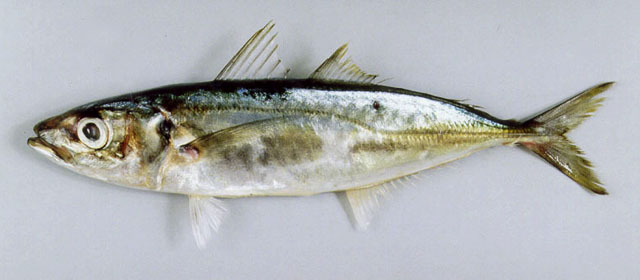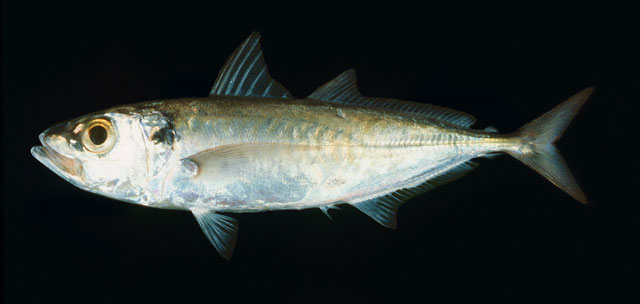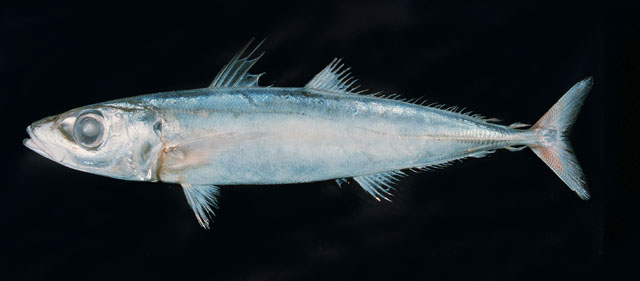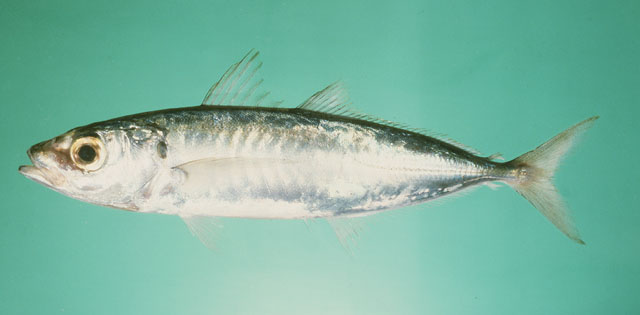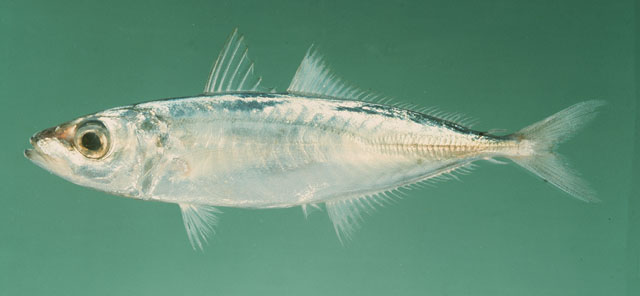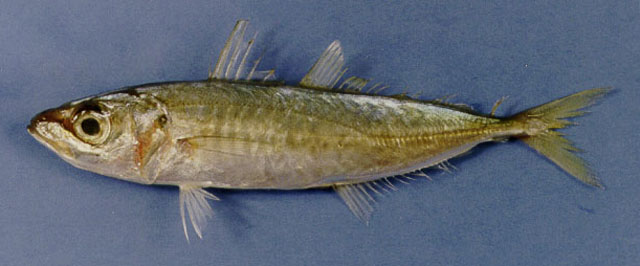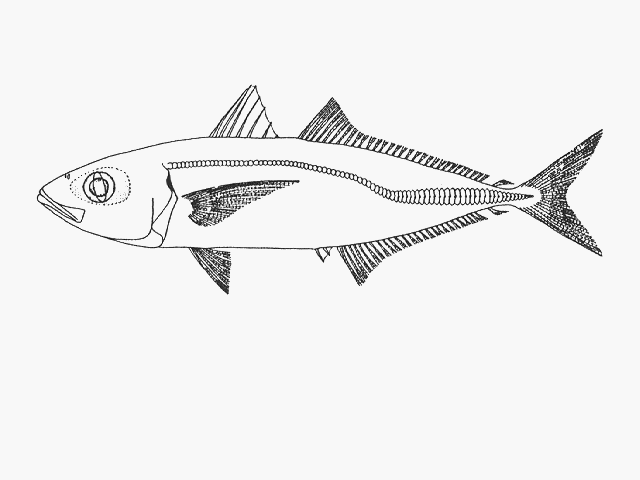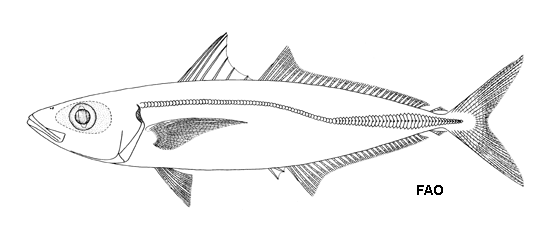Decapterus
russelli
(Rüppell,
1830)
Indian scad
View all media / Upload your photos and videos
Expand all
Classification / Names
Teleostei (teleosts) > Carangiformes (Jacks) >
Carangidae (Jacks and pompanos)
> Caranginae
Etymology: Decapterus: Greek, deka = ten + Greek, pteron = wing, fin (Ref. 45335).
More on author:
Rüppell.
Environment / milieu / depth range / climate zone / distribution range
Marine; benthopelagic; depth range 40 - 275 m (Ref. 12260); tropical; 40°N - 36°S18°E - 172°E.
Distribution
Maps

Decapterus russelli / Native range
AquaMaps Data sources:
GBIF
OBIS
This map was computer-generated and has not yet been reviewed.

Decapterus russelli / Suitable habitat
AquaMaps Data sources:
GBIF
OBIS
This map was computer-generated and has not yet been reviewed.

Decapterus russelli / Point map
AquaMaps Data sources:
GBIF
OBIS
This map was computer-generated and has not yet been reviewed.

Decapterus russelli / Year 2050
AquaMaps Data sources:
GBIF
OBIS
This map was computer-generated and has not yet been reviewed.
Length at first maturity / Size / Weight / Age
Short description
Dorsal spines (total): 9; Dorsal soft rays (total): 28 - 31; Anal spines: 3; Anal soft rays: 25 - 28; Vertebrae: 24. Lateral line curved below soft dorsal and with 30-44 strong scutes; color bluish green above, silvery below; caudal fin hyaline to yellowish; dorsal fins hyaline basally, light dusky distally. Opercle with small, black spot; opercular membrane with smooth margin. Snout longer than eye diameter; squarish lower posterior edge of maxilla; upper jaw with small teeth anteriorly; soft dorsal and anal fins relatively low, not falcate; pectoral fin sub falcate. (Other source of data on morphology: Ref. 3131, 3197, 3287).
Biology
Adults dwell from middle to benthic (Ref. 11230), forming large schools in deep water, but occasionally inshore in sheltered bays in small to large groups (Ref. 48635). The most common Decapterus in coastal waters and on open banks of the Indian Ocean. They feed mainly on smaller planktonic invertebrates. Generally marketed fresh, may be dried or salted. Also sold frozen and canned (Ref. 9987).
Main reference
Paxton, J.R., D.F. Hoese, G.R. Allen and J.E. Hanley 1989 Pisces. Petromyzontidae to Carangidae. Zoological Catalogue of Australia, Vol. 7. Australian Government Publishing Service, Canberra, 665 p. (Ref. 7300)
IUCN Red List Status (Ref. 125652)
Least Concern (LC); date assessed: February 04 2009
CITES (Ref. 123416)
Not Evaluated
CMS (Ref. 116361)
Not Evaluated
Threat to humans
Harmless
More information
- Countries
- FAO areas
- Ecosystems
- Occurrences
- Introductions
- Stocks
- Ecology
- Diet
- Food items
- Food consumption
- Ration
- Common names
- Synonyms
- Metabolism
- Predators
- Ecotoxicology
- Reproduction
- Maturity
- Spawning
- Spawning aggregation
- Fecundity
- Eggs
- Egg development
- Age/Size
- Growth
- Length-weight
- Length-length
- Length-frequencies
- Morphometrics
- Morphology
- Larvae
- Larval dynamics
- Recruitment
- Abundance
- References
- Aquaculture
- Aquaculture profile
- Strains
- Genetics
- Allele frequencies
- Heritability
- Diseases
- Processing
- Mass conversion
- Vision
- Pictures
- Stamps, Coins Misc.
- Sounds
- Ciguatera
- Speed
- Swim. type
- Gill area
- Otoliths
- Brains
Estimates based on models
Preferred temperature (Ref. 123201): 16.8 - 27.4, mean 23.2 °C (based on 690 cells).
Phylogenetic diversity index (Ref. 82804): PD50 = 0.501 [Uniqueness, from 0.5 = low to 2.0 = high].
Bayesian length-weight: a=0.01047 (0.00917 - 0.01196), b=2.96 (2.93 - 2.99), in cm total length, based on LWR estimates for this species (Ref. 93245).
Trophic level (Ref. 69278): 3.7 ±0.4 se; Based on diet studies.
Generation time: 1.5 (1.2 - 1.7) years. Estimated as median ln(3)/K based on 28 growth studies.
Resilience (Ref. 120179): Medium, minimum population doubling time 1.4 - 4.4 years (K=0.2-1.4; tm=3; Fec=20,000; tmax>3).
Prior r = 0.68, 95% CL = 0.45 - 1.03, Based on 16 data-limited stock assessments.
Fishing vulnerability (Ref. 59153): Low vulnerability (24 of 100).
Climate vulnerability (Ref. 125649): Moderate vulnerability (42 of 100).
Price category (Ref. 80766): Low; Reliable: based on ex-vessel price for this species.
Nutrients (Ref. 124155): Calcium = 394 [150, 1,297] mg/100g; Iron = 3.4 [1.2, 8.1] mg/100g; Protein = 19.4 [18.0, 20.9] %; Omega3 = 0.359 [0.161, 0.825] g/100g; Selenium = 148 [46, 441] μg/100g; VitaminA = 10.8 [2.3, 46.9] μg/100g; Zinc = 1.31 [0.73, 2.52] mg/100g (wet weight); based on nutrient studies.

